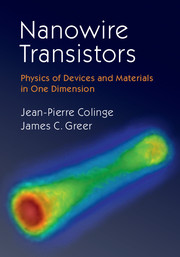Book contents
- Frontmatter
- Dedication
- Contents
- Preface
- 1 Introduction
- 2 Multigate and Nanowire Transistors
- 3 Synthesis and Fabrication of Semiconductor Nanowires
- 4 Quantum Mechanics in One Dimension
- 5 Nanowire Electronic Structure
- 6 Charge Transport in Quasi-1d Nanostructures
- 7 Nanowire Transistor Circuits
- Index
- References
5 - Nanowire Electronic Structure
Published online by Cambridge University Press: 05 April 2016
- Frontmatter
- Dedication
- Contents
- Preface
- 1 Introduction
- 2 Multigate and Nanowire Transistors
- 3 Synthesis and Fabrication of Semiconductor Nanowires
- 4 Quantum Mechanics in One Dimension
- 5 Nanowire Electronic Structure
- 6 Charge Transport in Quasi-1d Nanostructures
- 7 Nanowire Transistor Circuits
- Index
- References
Summary
Overview
The electronic structure of a semiconductor nanowire can vary substantially with respect to bulk material properties due to orientation, diameter, strain, quantum confinement, and surface effects. Before introducing the electronic structure of nanowires, the crystal structures of common group IV and III-V binary compounds are introduced. Semiconductor nanowires, even for diameters of a few nanometers, can retain the bonding characteristic of their bulk crystalline forms. This permits classification of nanowires by the crystal orientation aligned to the nanowire long, axial, or “growth” axis. To determine electronic structures of materials generally requires a combination of experimental and theoretical approaches in a fruitful collaboration whereby the strengths of several methods are used to complement one another. Elementary analysis of band structures is considered in relation to the observed properties of materials leading to their categorization as insulators, semiconductors, semimetals, and metals. These basic material categories are the fundamental building blocks for nanoelectronic devices. A brief discussion of experimental and theoretical methods for the determination of electronic properties is given to provide background on the state-of-the-art for electronic structure characterization and calculations. The electronic band structures of common bulk semiconductors are presented for reference. Atomic scale models for nanowires oriented along different crystal directions are introduced with the relationship between confinement normal to a nanowire's long axis and electronic structure expressed in terms of band folding. Representative electronic band structures are then introduced for different nanowire systems based on diameter and orientation to highlight the key effects of reduced dimensionality on electronic structure.
Semiconductor crystal structures: group IV and III-V materials
Group IV bonding and the diamond crystal structure
Silicon crystallizes in a cubic crystal structure that has the same symmetry as the diamond form of carbon. This structure is referred to as the diamond cubic crystal structure or sometimes more colloquially as the “diamond lattice.” The local bonding characteristic of the diamond crystal structure is largely retained when nanowires are patterned from crystalline silicon or grown from bottom-up processes such as those described in Chapter 3. In the diamond structure, each atom is tetrahedrally bonded to four nearest neighbor atoms. Many materials can also exist in amorphous form whereby the long-range order of a crystal is lost.
- Type
- Chapter
- Information
- Nanowire TransistorsPhysics of Devices and Materials in One Dimension, pp. 107 - 166Publisher: Cambridge University PressPrint publication year: 2016



